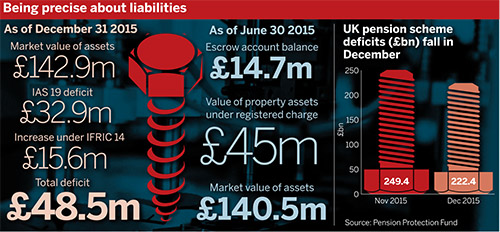Renishaw recognises true liability as IFRIC 14 bites
Gloucestershire-based engineering company Renishaw’s defined benefit liabilities jumped £15.6m above the IAS 19 accounting deficit at the end of last year, as experts highlighted the impact the accounting measure IFRIC 14 has on scheme valuations.
The company has given its pension scheme a guarantee relating to its recovery plan, which allows the trustees to recover any deficit up to £47.3m if the sponsor has not made good any deficit of equivalent value or goes insolvent before November 1 2016.
You’ve committed to putting money into the scheme that you can’t recover and so that is the liability you have to recognise
While the scheme’s IAS 19 deficit is £32.9m according to Renishaw’s latest half-year results, the company had to disclose the full value of its guarantee to the scheme under the accounting rule IFRIC 14.
In the results, Renishaw said: “The UK DB pension scheme’s liabilities were increased by £15.6m to represent the maximum discounted liability, as the value of the guarantee was that amount higher than the value of the pension scheme’s deficit.”
Alan Collins, head of trustee advisory services at consultancy Spence & Partners, said IFRIC 14 requires companies to show the true extent of what they could be asked to pay to the scheme.
“It’s really trying to get the accounts to recognise the undertaking the company has made. The company is potentially on the hook for £47.3m,” he said.
“You’ve committed to putting money into the scheme that you can’t recover, and so that is the liability you have to recognise.”
The fact the money cannot be recovered is what is important as, technically, employers that could get a refund from their scheme are not required to make the disclosure.
Hugh Nolan, chief actuary at consultancy JLT Employee Benefits, said: “For a scheme that could get the money out later they would not have to disclose this.”
He continued: “For this scheme there’s no chance you’ll get that money back once you’ve put it in.”
Nolan said employers in a similar situation that could recover the money would be disclosing a smaller figure, despite potentially having to pay more. “For those schemes, the accounting deficit would be massively understated.”
Pub group tops up recovery plan
UK pub, bar and restaurant operator Mitchells & Butlers entered into a 10-year recovery plan with its pension scheme trustees in 2014, agreeing annual contributions of £45m until 2023, with an additional one-off payment of £40m paid in September last year.
Under accounting standard IFRIC 14, the company recognises an additional liability in relation to a £350m minimum funding requirement agreed with trustees.
In the year to September 26 2015 the scheme’s actuarial deficit fell to £102m, from £193m in 2014, but the company recognised an additional £248m liability under terms of the minimum funding requirement in its latest annual report.
Charles Cowling, director at consultancy JLT, said in most cases scheme liabilities accounted for on company balance sheets are lower than the level agreed with scheme trustees.
Where schemes do not have provision to allow surpluses to be paid back to the sponsor, Cowling said companies must recognise the higher liability value. “But arguably everyone is affected,” he said. “This highlights that... deficits could be bigger than shareholders estimate.”
Richard Farr, managing director at covenant adviser Lincoln Pensions, said the accounting figure for valuing pensions was “designed to be a comparator between different companies”, which is why the accounting valuation is different from the technical provisions figure.
“It’s an old standard that needs refreshing,” he said.
Revising the figures
Last year the International Accounting Standards Board published its draft of amendments to IFRIC 14 in a document titled ‘IAS 19 – The limit on a defined benefit asset, minimum funding requirements and their interaction’.
This gave additional clarity on how the ability to recover a surplus could be assessed. Most recently, the amendments have led to Royal Bank of Scotland accelerating the recognition of £4.2bn of guaranteed future contributions.


